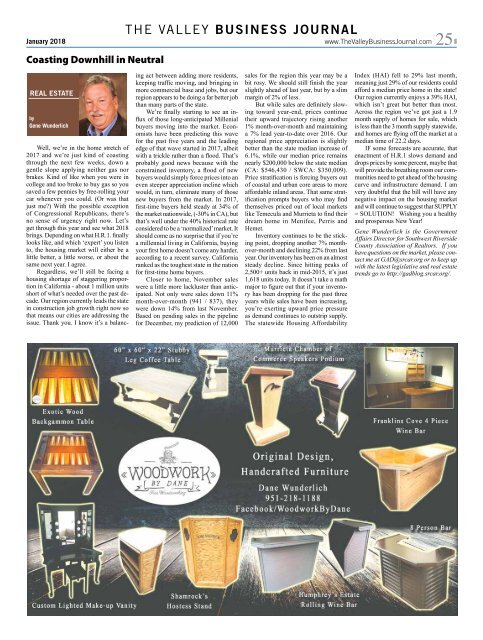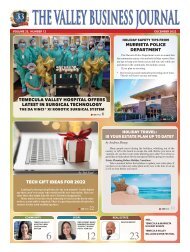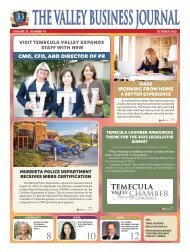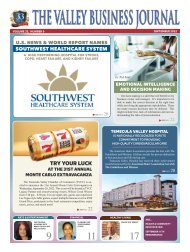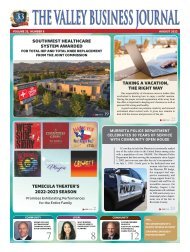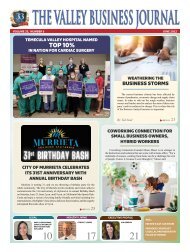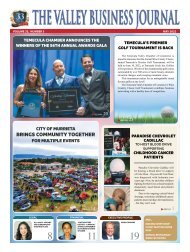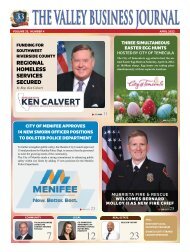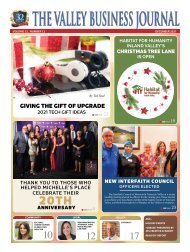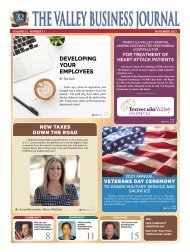January 2018
Create successful ePaper yourself
Turn your PDF publications into a flip-book with our unique Google optimized e-Paper software.
<strong>January</strong> <strong>2018</strong><br />
Coasting Downhill in Neutral<br />
THE VALLEY BUSINESS JOURNAL<br />
www.TheValleyBusinessJournal.com<br />
25<br />
REAL ESTATE<br />
by by<br />
Gene Steve Wunderlich Fillingim<br />
Well, we’re in the home stretch of<br />
2017 and we’re just kind of coasting<br />
through the next few weeks, down a<br />
gentle slope applying neither gas nor<br />
brakes. Kind of like when you were in<br />
college and too broke to buy gas so you<br />
saved a few pennies by free-rolling your<br />
car whenever you could. (Or was that<br />
just me?) With the possible exception<br />
of Congressional Republicans, there’s<br />
no sense of urgency right now. Let’s<br />
get through this year and see what <strong>2018</strong><br />
brings. Depending on what H.R.1. finally<br />
looks like, and which ‘expert’ you listen<br />
to, the housing market will either be a<br />
little better, a little worse, or about the<br />
same next year. I agree.<br />
Regardless, we’ll still be facing a<br />
housing shortage of staggering proportion<br />
in California - about 1 million units<br />
short of what’s needed over the past decade.<br />
Our region currently leads the state<br />
in construction job growth right now so<br />
that means our cities are addressing the<br />
issue. Thank you. I know it’s a balancing<br />
act between adding more residents,<br />
keeping traffic moving, and bringing in<br />
more commercial base and jobs, but our<br />
region appears to be doing a far better job<br />
than many parts of the state.<br />
We’re finally starting to see an influx<br />
of those long-anticipated Millenial<br />
buyers moving into the market. Economists<br />
have been predicting this wave<br />
for the past five years and the leading<br />
edge of that wave started in 2017, albeit<br />
with a trickle rather than a flood. That’s<br />
probably good news because with the<br />
constrained inventory, a flood of new<br />
buyers would simply force prices into an<br />
even steeper appreciation incline which<br />
would, in turn, eliminate many of those<br />
new buyers from the market. In 2017,<br />
first-time buyers held steady at 34% of<br />
the market nationwide, (-30% in CA), but<br />
that’s well under the 40% historical rate<br />
considered to be a ‘normalized’ market. It<br />
should come as no surprise that if you’re<br />
a millennial living in California, buying<br />
your first home doesn’t come any harder,<br />
according to a recent survey. California<br />
ranked as the toughest state in the nation<br />
for first-time home buyers.<br />
Closer to home, November sales<br />
were a little more lackluster than anticipated.<br />
Not only were sales down 11%<br />
month-over-month (941 / 837), they<br />
were down 14% from last November.<br />
Based on pending sales in the pipeline<br />
for December, my prediction of 12,000<br />
sales for the region this year may be a<br />
bit rosy. We should still finish the year<br />
slightly ahead of last year, but by a slim<br />
margin of 2% of less.<br />
But while sales are definitely slowing<br />
toward year-end, prices continue<br />
their upward trajectory rising another<br />
1% month-over-month and maintaining<br />
a 7% lead year-to-date over 2016. Our<br />
regional price appreciation is slightly<br />
better than the state median increase of<br />
6.1%, while our median price remains<br />
nearly $200,000 below the state median<br />
(CA: $546,430 / SWCA: $350,009).<br />
Price stratification is forcing buyers out<br />
of coastal and urban core areas to more<br />
affordable inland areas. That same stratification<br />
prompts buyers who may find<br />
themselves priced out of local markets<br />
like Temecula and Murrieta to find their<br />
dream home in Menifee, Perris and<br />
Hemet.<br />
Inventory continues to be the sticking<br />
point, dropping another 7% monthover-month<br />
and declining 22% from last<br />
year. Our inventory has been on an almost<br />
steady decline. Since hitting peaks of<br />
2,500+ units back in mid-2015, it’s just<br />
1,618 units today. It doesn’t take a math<br />
major to figure out that if your inventory<br />
has been dropping for the past three<br />
years while sales have been increasing,<br />
you’re exerting upward price pressure<br />
as demand continues to outstrip supply.<br />
The statewide Housing Affordability<br />
Index (HAI) fell to 29% last month,<br />
meaning just 29% of our residents could<br />
afford a median price home in the state!<br />
Our region currently enjoys a 39% HAI,<br />
which isn’t great but better than most.<br />
Across the region we’ve got just a 1.9<br />
month supply of homes for sale, which<br />
is less than the 3 month supply statewide,<br />
and homes are flying off the market at a<br />
median time of 22.2 days.<br />
IF some forecasts are accurate, that<br />
enactment of H.R.1 slows demand and<br />
drops prices by some percent, maybe that<br />
will provide the breathing room our communities<br />
need to get ahead of the housing<br />
curve and infrastructure demand. I am<br />
very doubtful that the bill will have any<br />
negative impact on the housing market<br />
and will continue to suggest that SUPPLY<br />
= SOLUTION! Wishing you a healthy<br />
and prosperous New Year!<br />
Gene Wunderlich is the Government<br />
Affairs Director for Southwest Riverside<br />
County Association of Realtors. If you<br />
have questions on the market, please contact<br />
me at GAD@srcar.org or to keep up<br />
with the latest legislative and real estate<br />
trends go to http://gadblog.srcar.org/.


